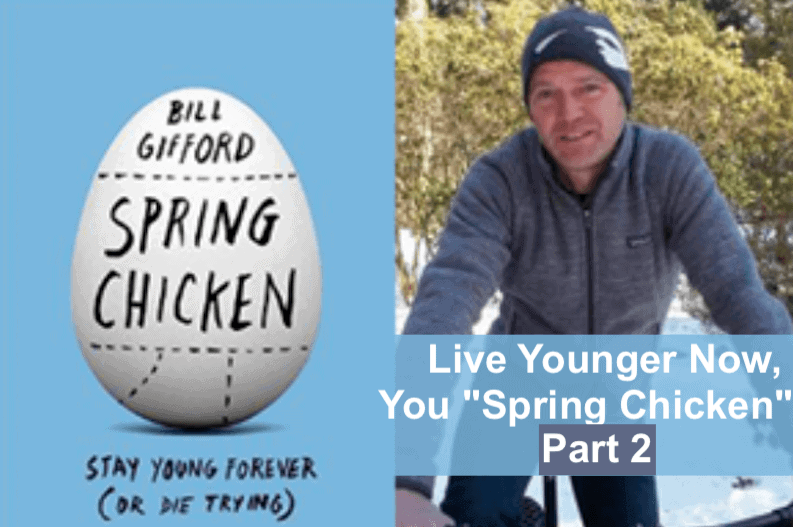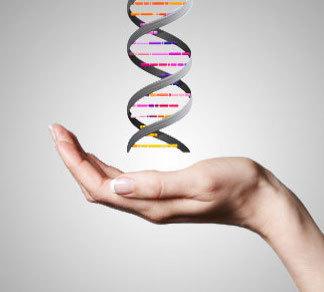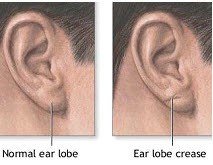Bill Gifford: Live Younger Now, You “Spring Chicken” — Part 2
Bill Gifford’s book about how to live younger will delight and inform. But the best part is that’s it’s brimming with sage, research-tested advice about how to — as I like to say — live long and strong.
LAST WEEK I dove into Part 1 of Bill Gifford’s best seller, Spring Chicken, Stay Young Forever (Or Die Trying) where we got a handle on why it’s not aging itself that kills you, but the chronic diseases that get sufficiently severe over time to do the job all by themselves. Along with that was the story on Human Growth Hormone and IGF-1, how age is measured and why energy is a key focus in the march toward a long, hale life.
Now here in Part 2 we’re going to look at:
- Genetics or lifestyle — which most determines your health and lifespan?
- Cholesterol’s role in heart/artery elasticity and heart disease, and some tests you can do now by your very own self.
- What you can do to keep your heart ticking a long time.
- What’s the deal with baldness/receding hair?
As I said in Part 1, I’m going to share a lot of nuggets from Spring Chicken, but there’s a lot left to chew on in this book, so go buy it!
That said, let’s dig in…
Chapter 5: “How to Live to 108 Without Really Trying” — Tune your genes to live younger
The fast answer on how to live to 108 without really trying is to be born with the right longevity genes. Certainly that’ s the case for the centenarians Bill Gifford profiled in his book. (The rest of us will have to actually try, and thankfully, there are things we can do to improve healthspan, if not lifespan.)
Dr. Nir Barzilai, the Founding Director of the Institute for Aging Research (among other things), has been studying a cluster of Ashkenazi Jewish centenarians who live in the New York area, which has led him to some remarkable conclusions.

Irving Kahn, once the world’s oldest active investor (he lived to 109), was among Dr. Barzilai’s centenarian cohort.
Mostly, he found that his centenarians do not generally eat “healthy” diets nor do anything else that is suspected to improve lifespan, such as exercise and take supplements. In fact, some even did the opposite, like smoke for decades and get overweight, even obese. None of that seemed to matter, because they aced blood tests that test for various health biometrics; in particular, they tend to have spectacularly high levels of HDL, the “good” cholesterol.
“Their blood is perfect”, says Dr. Barzilai.
Barzilai’s theory is that centenarians live longer simply because they age more slowly. That sounds obvious, but the interesting question is why? What genes are responsible for their slower aging?
The role genes have in determining longevity has long been debated. One direction scientists took in evaluating the role of genes was to see if they were immutably in control; meaning, do they completely determine longevity, or is there wiggle room?
The “wiggle room” part is basically what the science of Epigenetics is all about. It’s worth taking a detour from summarizing Bill Gifford’s book to explain it a bit.
Epigenetics is the study of biological mechanisms that will switch genes on and off. Yes, you might have the genes that give you a propensity for high blood sugar, but a low-sugar diet might cause them not to be “expressed” physiologically, suggests epigenetics.
The website, What Is Epigenetics uses an apt analogy:
Think of the human lifespan as a very long movie. The cells would be the actors and actresses, essential participants in the movie. DNA is the script — instructions for all the participants of the movie to do their roles. The DNA sequence would be the words on the script, and certain blocks of these words that instruct key actions or events to take place would be the genes. The concept of genetics would be like screenwriting. The concept of epigenetics, then, would be like directing. The script can be the same, but the director can choose to cut or tweak certain scenes or dialogue, altering the movie for better or worse. After all, Steven Spielberg’s finished product would be different than Woody Allen’s for the same movie script, wouldn’t it?
Honey, It’s Twins!
A really good way to study the role of epigenetics is to study identical twins who grow up in different environments and select different lifestyle choices.
Studies of Danish twins who were raised and had lived their lives apart revealed that longevity is only 20% inherited, and 80% due to environmental factors.
Sweet — that means our health and longevity is largely in our own hands. And it is until about age eighty-five. After that, heredity moves to the forefront, making those genes you’ve inherited 50% of the story, if not more.
But it’s a battle worth fighting.
Nir Barzilai has said. “We are certain, there is no doubt in our minds, that exceptional longevity is mainly inherited”, but then gene sequencing technology and a better understanding of the role of genes in disease happened, which revealed that many centenarians have some of the same crappy genes as the rest of us.
Protective Genes Are Key
Barzilai and his team sequenced the genomes of forty-four centenarians and found that nearly all of them possessed undesirable gene variants that are thought to promote heart disease, Alzheimer’s, Parkinson’s and other unsavory health outcomes, yet none of them had gone on to develop any of those diseases. Given those genes, these centenarians who should have dementia at seventy, and be dead at eighty, are living to a hundred!
Why?
Dr. Barzilai reasoned that reason they’re not succumbing to the diseases that their disease-related genes would normally induce is that the long-lived must instead have protective genes, which prevent them from developing the usual diseases of old age.
He decided to zero in on their cholesterol-related genes, because his centenarians had such excellent blood values and perfect cardiac health. He found that many of them had a specific gene variant that inhibits something called CETP (“cholesterol ester transfer protein”), a molecule involved in cholesterol processing.
The less CETP you have, the better; high levels of the protein are thought to lead to premature atherosclerosis. Centenarians with the CETP-inhibiting mutation not only had better heart health, and very high “good” cholesterol, but they also had a lower incidence of memory loss and dementia.
Chapter 6: “The Heart of the Problem” — Keep it beating, or else
Men are born soft and supple; dead, they are stiff and hard. Plants are born tender and pliant; dead, they are brittle and dry. Thus whoever is stiff and inflexible is a disciple of death. Whoever is soft and yielding is a disciple of life. The hard and stiff will be broken. The soft and supple will prevail. —Lao Tzu
One simple and easy to do test of your elasticity is the skin pinch test.
Pinch a fold of skin from the back of your hand for two seconds and then let go. Elastic skin immediately springs back, the fold disappearing near instantaneously. Inelastic skin keeps the fold intact for a bit before again blending back to its normal appearance.
Basically, skin elasticity is governed by two molecules: collagen and elastin:
- Collagen is a tough, rubbery substance that gives structure to lips and tendons and skin.
- Elastin is a highly elastic protein in connective tissue and allows many tissues in the body to resume their shape after stretching or contracting, and is why your skin snaps back from a smile or frown, or when the skin on the back of your hand gets pinched.
But elasticity goes well beyond skin; it affects lung function, heart function and more.
I’m going to get back to elasticity in a bit, but first I want to share some insights Bill Gifford offers about heart disease. Please pay attention, because it gets complicated and yet you need to know about what’s behind this number one killer.
The Story of Heart Disease in 9 Parts
(1) Coronary arteriosclerosis— thickening and stiffening of the main artery leading from the heart— was found in 77% of a group of three hundred Americans killed in the Korean war; average age — only 22! In two-thirds of male patients, the first sign of heart disease is a heart attack. For women, that number is more like half, still alarmingly high. It seems we’re hard-wired for heart disease; it’s only a matter of time, some medical types assert.
(2) The famous Framingham study, now on-going for 50 years, has set the stage for much of what we know about heart disease, such as the link between high cholesterol and the likelihood of heart attacks (that link disputed by some), along with four other key risk factors: obesity, diabetes, high blood pressure, and smoking. In 2006, a team of epidemiologists laid out the bottom line in a major study published in Circulation, the journal of the American Heart Association:
“Even the presence of a single major risk factor at 50 years of age is associated with substantially increased lifetime risk of CVD [cardiovascular disease] and markedly shorter survival.”
(3) A condition called atherosclerosis occurs when LDL particles get “stuck” in tiny fissures in the artery walls, creating “plaques” that then capture more cholesterol and other cellular junk as it passes by in the bloodstream, “the way a tree falling into a river will snag all sorts of debris in its branches”, says Gifford. They then become harden and constrict blood flow, a condition called atherosclerosis (different from arteriosclerosis, #1 above, which is hardening of the artery tissue itself). If the plaques suddenly rupture and break off, they head directly to the heart and may cause a heart attack.
(4) Statins only seem to help those with existing problems, but don’t work as primary prevention. “You should see a decline in overall mortality, and you don’t,” says Nir Barzilai.
(5) Although cholesterol remains the most obvious, most quantifiable risk factor for heart disease, recently, there’s been some doubt whether cholesterol tells the tale in its entirety. A major study of 136,000 patients who had experienced a coronary “event” found that half of them actually had low LDL cholesterol. Former TV journalist Tim Russert was one of them. When he died of sudden heart attack in 2008, his LDL was a heart-healthy 68 mgdL. Yes, he was overweight (a risk factor) and was on blood pressure medication, but presented no serious symptoms before an arterial plaque ruptured and killed him at age 58. (6) In addition to being overweight, visible indicators of potential heart disease are: (7) Not all types of LDL are the same (same for HDL). What matters more than the number (mg/dL) is the particle size. The body needs a small amount of blood cholesterol because the body uses it to: build the structure of cell membranes, make hormones like oestrogen, testosterone and adrenal hormones. help your metabolism work efficiently and make vitamin D. LDL’s is carted around your blood in special carrier molecules, which vary considerably in size. A small number of large carrier molecules is better than a large number of small carriers, in the same way that it would be safer to transport fifty tourists around Rome in a single large bus rather than on fifty separate mopeds, explains Gifford. “Just as the mopeds would be much more likely to get into accidents, a bunch of small carrier molecules would have more opportunities to stick into my artery walls and cause plaques that might eventually kill me.” Each carrier molecule is marked by a protein called apolipoprotein B, or ApoB. Major studies going back nearly fifteen years have shown that ApoB is a much better predictor of risk than plain old LDL, and some researchers have suggested that doctors should focus more on ApoB instead, a conclusion drawn by the health care systems throughout much of Europe which test for ApoB. (8) Those whose diets are dominated by plants (veggies, legumes, whole fruits) have fewer incidence of heart disease than those whose diets comprised mostly of meat and dairy. Red meat has long been known to be a risk factor for heart disease, mainly due to its fat content. Recent research has made this long-standing “truth” debatable and has identified another possible culprit, Carnitine — an amino acid found in red meat. In the body, carnitine is metabolized to a chemical called TMAO that causes atherosclerosis. Researchers have pinpointed particular gut microbes in most people who are responsible for producing TMAO— but longtime vegetarians, who don’t have those specific microbes in their guts, do not make TMAO when eating red meat. In yet another display of Bill Gifford’s humor sprinkled liberally throughout Spring Chicken is his observation that: “… it is apparently only safe to eat meat if you’re a vegetarian.” (9) Finally, we’re back to Flexibility. Here’s what happens to our cardiovascular system as we age: Controlling blood pressure helps, either with medication, exercise or meditation, which has actually been shown to work in studies, believe it or not. Read Meditate Like A Monk In 20 Minutes Reducing abdominal fat is a mighty fine idea, given that it’s either a cause or contributor to left ventricle problems in the heart (the main pumping chamber). Read 22 Belly Fat Tips From Three Experts That Will Make You Healthy and Lean Long-term aerobic exercise and strength training can cut your risk of cardiac hypertrophy — the younger you make this a lifestyle, the more resilient your heart will be in those twilight years. Begin with The Functionally Fit Fast Workout The word “metaphor” is in the title of Chapter 7, and I wondered what it would be as I began reading it. And just how much baldness are you talking about here, Mr. Gifford, I wondered as I ran my hands through resilient wisps. Here’s a few things that I learned about baldness/receding hair: Read Your Doctor Recommended 13 Steps To Reverse Hair Loss See Dr. Weil’s Anti-inflammation Diet and The Golden Spice So far, I haven’t mentioned anything that explains the metaphor, and I won’t simply because I remain unsure to what Bill Gifford refers. What I do know is that in Chapter 7, Gifford moves away from hair and deep into theories of why some critters live longer than others, ending it with what clearly is a huge reason behind aging, and where Part 3 of my review of Spring Chicken will begin: Longer-lived animals have hardier cells! Stay tuned for Part 3 on how to live younger, longer. Remember these three things: If you haven’t done so already, read Part 1. Last Updated on February 28, 2022 by Joe Garma
What You Can Do To Preserve Your Heart
Chapter 7: “Baldness As A Metaphor” — Inflammation, again
Your Takeaway On How to Live Younger








